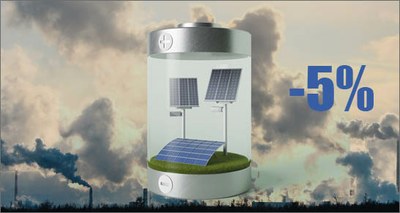Energy: Air pollution affects energy yield of photovoltaic systems
15/7/2021
 In Italy, air pollution has a significant impact on photovoltaic yield, with average annual losses of 5% caused by atmospheric particulate alone (PM2.5) and peaks that can reach double digits in areas particularly polluted by fine dust, as reported by a study conducted at the ENEA Portici Research Center (Naples), jointly with the Department of Environmental Engineering of the Federico II University of Naples.
In Italy, air pollution has a significant impact on photovoltaic yield, with average annual losses of 5% caused by atmospheric particulate alone (PM2.5) and peaks that can reach double digits in areas particularly polluted by fine dust, as reported by a study conducted at the ENEA Portici Research Center (Naples), jointly with the Department of Environmental Engineering of the Federico II University of Naples.
"This is a crucial issue for an energy source like photovoltaic, characterized by low power densities per unit of plant area, especially if we consider the goals envisaged by the PNIEC [1] and the PNRR[2] which show, once more, how energy production and consumption must go hand in hand with environmental protection", explained Girolamo Di Francia, Head of the ENEA Laboratory for the Development of Digital Photovoltaic and Sensoristic Applications.
The impact of fine particles on the yield of plants was the subject of another study [3] published in the journal "Nature Energy" and relating to China, where it was calculated that production capacity decreased by 13% due to pollution. "By analyzing how optical detectors for fine particles work, we realized that the particulate matter significantly disperses solar radiation, precisely in the wavelength range in which solar cells are expected to work best", Di Francia said .
The analyses conducted by ENEA and "Federico II" regarded municipalities in the Campania region, using data from the air quality monitoring stations of ARPAC [4] and COPERNICUS, the Earth observation program of the European Union, in addition to other data from measurements carried out specifically in Portici, and developing different methods of analysis based on conspicuous literature.
"We have one of the few laboratories in the world capable of conducting this study both from an experimental and modeling point of view, thanks to our long standing and quite unique expertise in the detection of atmospheric pollution on the ground as well as in issues related to the development of photovoltaics applications”, Di Francia said.
For more information please contact:
Girolamo Di Francia, ENEA – Development of Digital, Photovoltaic and Sensoristic Applications Laboratory, girolamo.difrancia@enea.it
[1] Integrated National Plan for Energy and Climate 2030
[2] National Recovery and Resilience Plan
[3] Estimation of losses in solar energy production from air pollution in China since 1960 using surface radiation data https://www.nature.com/articles/s41560-019-0412-4
[4] Regional Agency for the Protection of the Environment (Campania)
